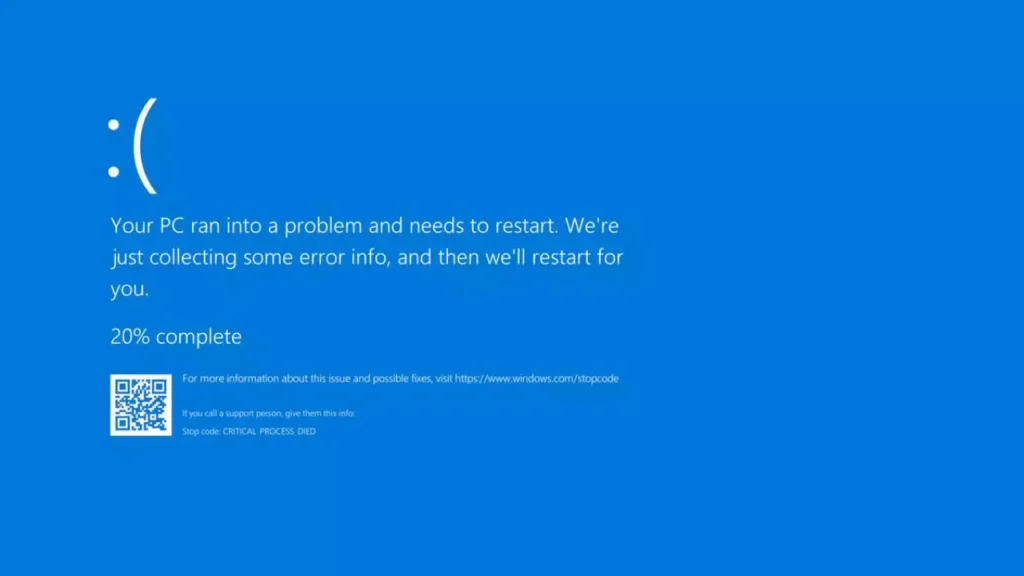On July 18, 2024, the digital world experienced a significant disruption known as “The Great Fall,” when a global outage affected millions of users and brought critical services to a standstill. The root cause of this widespread issue was traced back to a software update from the cybersecurity company CrowdStrike.The incident originated from a null pointer issue in CrowdStrike’s software update, which caused Windows systems to crash and display the infamous “blue screen of death.” This seemingly minor bug had far-reaching consequences, affecting approximately 8.5 million Windows devices, representing less than 1% of all Windows machines. However, the impact was disproportionately large due to the critical nature of the affected systems.

The outage’s effects were felt across various sectors globally. In the airline industry, widespread cancellations and delays occurred, with Delta Air Lines alone reporting over 600 flight cancellations as of 10 a.m. EDT on July 20, 2024. This led to thousands of stranded passengers and significant disruptions to travel plans worldwide.
The healthcare sector was also severely impacted, with medical procedures delayed or canceled in many hospitals. Critical healthcare systems were affected, limiting access to patient records and disrupting essential medical services. This put patient care at risk and highlighted the vulnerability of digital infrastructure in critical sectors.
This incident also caused financial institutions to experience outages, leaving customers unable to access their accounts or conduct transactions. This ripple effect on the economy affects both individuals and businesses. Government and public services were not spared either, with courts and government offices forced to shut down, causing delays in legal proceedings and public services. The outage also inadvertently introduced new hacking vulnerabilities, including for federal agencies, heightening the risk of cyberattacks and data breaches.
In the aftermath, hackers quickly capitalized on the chaos by launching phishing attacks, creating fake websites, and distributing malware, mainly targeting Latin American customers. In response to the crisis, both CrowdStrike and Microsoft acted swiftly. CrowdStrike acknowledged the issue publicly and provided a workaround solution. Microsoft collaborated closely with CrowdStrike and external developers to expedite a resolution, offering technical guidance and support to help customers recover safely. The fix involved addressing the null pointer issue in CrowdStrike’s software to prevent further crashes.
Additionally, Microsoft posted instructions on the Windows Message Center to guide users on remedying the situation on their Windows endpoints. This recent happening serves as a reminder of the interconnectedness of our digital ecosystem and how a single software bug can trigger a domino effect, causing widespread disruptions across various services and geographical locations. It underscores the critical importance of rigorous code reviews and thorough testing before deploying updates, especially for software interacting with core system components.
Furthermore, “The Great Fall” highlights the need for greater resilience, redundancy, and cybersecurity measures in our increasingly interconnected digital world. As more and more reliance grows on a digital world, incidents like these emphasize the importance of robust contingency plans and systems that can withstand unforeseen challenges. In conclusion, the CrowdStrike-Microsoft outage of July 2024 will likely be remembered as a significant event in digital history. It serves as a valuable lesson for the tech industry, emphasizing the need for enhanced quality assurance processes, improved collaboration between tech giants, and the development of more resilient digital infrastructures to mitigate the impact of such large-scale disruptions in the future.
<Reference>
“Crowdstrike Faces Backlash as ‘thank You’ Gift Cards Are Blocked.” The Guardian, Guardian News and Media, 25 July 2024, www.theguardian.com/technology/article/2024/jul/25/crowdstrike-workers-ubereats-vouchers. Accessed 28 July 2024.
Browne, Ryan. “How a Software Update from Cyber Firm CrowdStrike Caused One of the World’s Biggest It Blackouts.” CNBC, 19 July 2024, www.cnbc.com/2024/07/19/what-is-crowdstrike-crwd-and-how-did-it-cause-global-it-outages.html. Accessed 28 July 2024.
Jada Sterling, Digital Content Manager. “2024 Microsoft Outage: See the Most Impacted Industries.” Usherwood Office Technology, 26 July 2024, www.usherwood.com/blog/2024-microsoft-outage-see-the-highest-impacted-industries. Accessed 28 July 2024.
Araullo, Kenneth. “CrowdStrike Microsoft Outage – What’s the Impact on Reinsurance?” Insurance Business Australia, Insurance Business, 23 July 2024, www.insurancebusinessmag.com/au/news/reinsurance/crowdstrike-microsoft-outage–whats-the-impact-on-reinsurance-498331.aspx#:~:text=The%20system%20failure%20caused%20by,complex%2C%20global%20IT%20supply%20chain. Accessed 28 July 2024.
Warren, Tom. “Microsoft Calls for Windows Changes and Resilience after Crowdstrike Outage.” The Verge, 26 July 2024, www.theverge.com/2024/7/26/24206719/microsoft-windows-changes-crowdstrike-kernel-driver. Accessed 28 July 2024.
Leave a Reply